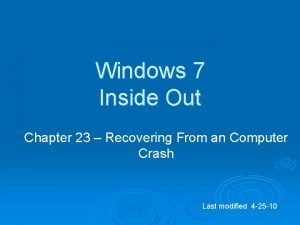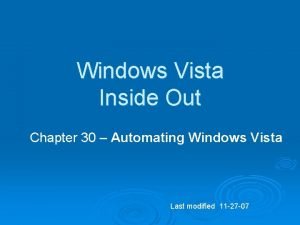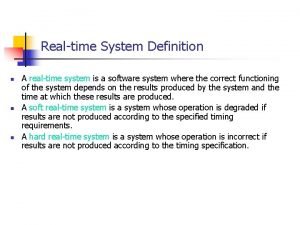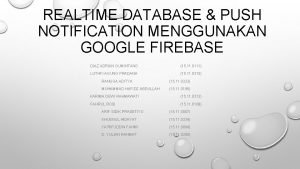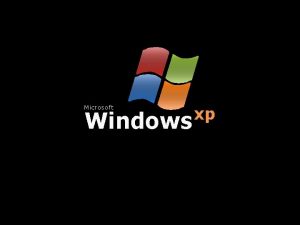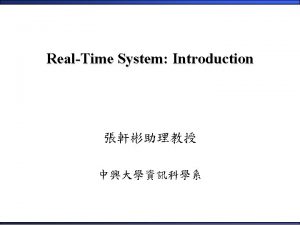Windows NT and RealTime Reading Inside Microsoft Windows







- Slides: 7

Windows NT and Real-Time? • Reading: “Inside Microsoft Windows 2000”, (Solomon, Russinovich, Microsoft Programming Series) • “Real-Time Systems and Microsoft Windows NT” (MSDN Library) • “Windows XP with RTX - The off-the-shelf platform for Integrated Communication Equipment” (www. venturcom. com)

Priorities in Windows NT/2000

Device Drivers in Windows NT/2000 device drivers run entirely within the system process and have access to all hardware through the HAL. A typical device driver will have several components: • Initialization routine This routine initializes hardware and sets up data structures used by the driver at startup time. • Interrupt service routine (ISR) This routine handles an interrupt on the device that the device driver controls. • Deferred processing call (DPC) One or more DPCs handle non–timecritical processing for the driver. • System thread Some, but not all, drivers will have a system thread for very low- priority work.

Priority Levels vs. Interrupt Levels • The HAL maps hardwareinterrupt numbers to IRQLs. • IRQLs are not the same as IRQs in x 86. • Scheduling priority is attribute of thread, while IRQL is attribute of an interrupt source. • Lazy IRQL management for slow PICs. • Code running at DPC/dispatch level or above can’t wait on object if so would necessitate scheduler to invoke another thread. Thread Priorities 0 -31 31: High 30: Power Fail 29: Inter-Processor Interrupt 28: Clock 27: Profile 26: Device n 3: Device 1 2 DPC/dispatch 1: APC 0: Passive Hardware Interrupts Software Interrupts

Memory Management • Paging I/O occurs at a lower priority level than the real-time priority process levels. Paging within the real-time process is still free to occur, but this really ensures that background virtual memory management won't interfere with processing at real-time priorities. • Windows NT permits an application to lock itself into memory so that it is not affected by paging within its own process. This allows even very large processes (such as raster image processing, where some processes are over 100 MB) to lock all their memory down into physical memory and avoid the overhead of paging, while allowing the rest of the system to function normally. • Windows NT memory management allows for memory mapping, which permits multiple processes—even device drivers and user applications—to share the same physical memory. This results in very fast data transfers between cooperating processes or between a driver and an application. Memory mapping can be used to dramatically enhance real-time performance.

Windows 2000/NT and Real-Time Processing • Windows 2000/NT does not prioritize device IRQs in controllable way. • User-level applications execute only when a processor’s IRQL is at passive level. • System’s devices and device drivers – not the OS – ultimately determine the worst-case delay. • This is a problem with off-the-shelf hardware and drivers. • System designer must bound the length of device’s ISR and DPC in the worst case. • Embedded versions of Windows NT/2000 provide control over memory footprint etc, but are not real-time capable. • Extensions of real-time kernels can be provided through custom extensions of the HAL.

Ventur. Com RTX Architecture



